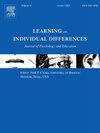From language to mathematics and vice versa?: A longitudinal study on the associations between preschoolers' mathematical language and mathematical abilities
IF 3.8
1区 心理学
Q1 PSYCHOLOGY, EDUCATIONAL
引用次数: 0
Abstract
Mathematical language, such as quantitative (e.g., few) and spatial (e.g., after) terms, is critical for mathematical development. However, studies often combine different aspects of mathematical language and focus primarily on numerical skills. Additionally, most data are cross-sectional, leaving the direction of the relation between mathematical language and abilities unclear. It is also important to understand whether these relations are specific to mathematical language or reflect general vocabulary. This longitudinal study tested 134 children on their mathematical language, general vocabulary and mathematical abilities at ages 4 and 5. Regression models controlling for children's earlier mathematical language and mathematical abilities showed that only spatial language, and not quantitative language predicted children's numerical competencies and measurement. We observed a unidirectional relation from early spatial language to later numerical competencies and measurement. When accounting for children's general vocabulary, spatial language, and general vocabulary, continued to predict children's measurement abilities, but not their numerical competencies.
从语言到数学,反之亦然?学龄前儿童数学语言与数学能力关系的纵向研究
数学语言,如定量术语(例如,few)和空间术语(例如,after),对数学发展至关重要。然而,研究往往结合了数学语言的不同方面,主要集中在数字技能上。此外,大多数数据都是横截面的,这使得数学语言和能力之间关系的方向不明确。了解这些关系是特定于数学语言还是反映一般词汇也很重要。这项纵向研究测试了134名4岁和5岁儿童的数学语言、一般词汇和数学能力。控制儿童早期数学语言和数学能力的回归模型表明,只有空间语言,而不是定量语言预测儿童的数字能力和测量。我们观察到从早期的空间语言到后来的数字能力和测量的单向关系。当考虑到儿童的一般词汇、空间语言和一般词汇时,继续预测儿童的测量能力,但不能预测他们的数字能力。
本文章由计算机程序翻译,如有差异,请以英文原文为准。
求助全文
约1分钟内获得全文
求助全文
来源期刊

Learning and Individual Differences
PSYCHOLOGY, EDUCATIONAL-
CiteScore
6.60
自引率
2.80%
发文量
86
期刊介绍:
Learning and Individual Differences is a research journal devoted to publishing articles of individual differences as they relate to learning within an educational context. The Journal focuses on original empirical studies of high theoretical and methodological rigor that that make a substantial scientific contribution. Learning and Individual Differences publishes original research. Manuscripts should be no longer than 7500 words of primary text (not including tables, figures, references).
 求助内容:
求助内容: 应助结果提醒方式:
应助结果提醒方式:


